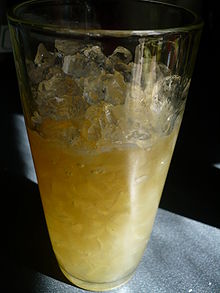Falernum
 Falernum and ice | |
| Type | Syrup liqueur or nonalcoholic syrup |
|---|---|
| Country of origin | Caribbean |
| Region of origin | Barbados and Caribbean |
| Alcohol by volume | 11% (syrup liqueur), varies for nonalcoholic syrup |
| Color | White to light amber, clear or translucent |
| Flavor | Ginger, lime, almond, cloves or allspice |
| Related products | Orgeat syrup |
Falernum (pronounced fə-LUR-nəm) is either a syrup liqueur or a nonalcoholic syrup from the Caribbean. It is best known for its use in tropical drinks. It contains flavors of ginger, lime, and almond, and frequently cloves or allspice. It may be thought of as a spicier version of orgeat syrup.
The form can be alcoholic (syrup liqueur) or nonalcoholic (syrup). Versions with alcohol are generally lower in proof (≈15% ABV), adding rum and emphasizing the clove, ginger, or allspice flavoring aspects for use in mixing cocktails, typically tropical or tiki drinks.[1] It is also enjoyed on the rocks.
Depending on sugar content, the consistency is often thick and is therefore sometimes referred to as "velvet falernum" because of the feeling it leaves on one's tongue. Brands vary. The color can be white to light amber, and it may be clear or translucent.[2]
History
[edit]Falernum may date back to the 18th century, when it was made as a punch in the areas around Barbados. Some disagreement exists over the origin of the name, and whether the earliest versions would have included the steeping of almonds. [3] The same references also assert that earlier versions contained bitters such as wormwood. The inclusion of bitters historically would seem to be corroborated by a 1982 article appearing in The New York Times.[4]
In the literary magazine All the Year Round, owned by Charles Dickens Jr. at the time, an unnamed author wrote of falernum in 1892, describing it as "a curious liqueur composed from rum and lime-juice".[5]
The earliest known reference in bar manuals seems to be the 1930s. One producer claims his recipe dates to 1890, winning awards as early as 1923.[6]
Use in cocktails
[edit]Drinks using falernum include:
- Better and Better[7]
- Captain's Blood Cocktail
- Corn 'n Oil (Barbados)[8]
- Frosty Dawn
- Key Cocktail
- Mai Tai (not Trader Vic's)[9]
- Port Antonio Cocktail
- Puka Punch[10]
- Royal Bermuda Cocktail
- Rum Collins (some variations)
- Bermuda Rum Swizzle
- Saturn Cocktail[11]
- White Lion
- Zombie (Don the Beachcomber's)
- Trader Sam's Uh-Oa!
- Tourist n’ Sugar
- Three Dots and a Dash[12]
See also
[edit]References
[edit]- ^ "Falernum liqueur moves beyond". punchdrink.com. 30 January 2017. Retrieved 31 January 2019.
- ^ Carrington, Sean; Fraser, Henry (2003). "Falernum". A–Z of Barbados Heritage. Macmillan Caribbean. p. 74. ISBN 0-333-92068-6.
A liqueur made basically from rum, lime and sugar. The origin of the name is something of a mystery. The authoritative Grossman's Guide states falernum was invented in Barbados over 200 years ago and was named after Falernum wine, which was much prized by the Romans. There is a joke which purports to explain how falernum got its name. In one version, the tourist, after tasting the drink, ask the old man how he made this delicious liqueur. After a few moments hesitation the old Barbadian replies 'you have fuh learn um' (you have to learn it). The following is reproduced from Mrs. H Graham Yearwoods's (1911) West Indian and Other Recipes: 'For 30 gallons of falernum: 9 gal. rum, 3 gal. lime juice, 1 gal. milk, ½ gal brandy, 56 lbs. sugar, ½ oz. bitter almond, ¼ oz. mace. To fine it, add 1 gal. of milk.' Rum and falernum constitute the drink known as Corn 'n Oil or 'Corning Oil'. The traditional rum cocktail is simply rum and sugar of rum and falernum shaken with ice and a dash of Angostura Aromatic Bitter.
- ^ "Falernum: The Elusive Cocktail Syrup". smithsonianmag.com. Retrieved 31 January 2019.
- ^ Deitz, Paula (14 April 1982). "IN THE LORE OF BARBADOS". The New York Times. Retrieved 31 January 2019.
- ^ All the Year Round. Chapman and Hall. 1892.
- ^ Carrington, Sean; Fraser, Henry (2003). "Falernum". A–Z of Barbados Heritage. Macmillan Caribbean. p. 74. ISBN 0-333-92068-6.
- ^ "Better and Better Cocktail". The New York Times. Retrieved 21 December 2019.
- ^ "Corn 'n Oil". punchdrink.com. Retrieved 31 January 2019.
- ^ Arnold Bitner, Phoebe Beach (2001), Hawaii Tropical Rum Drinks & Cuisine by Don the Beachcomber (in German), Mutual Pub Co, ISBN 978-1566474917
- ^ "Puka Punch". cocktailpartyap.com. 21 July 2017. Retrieved 31 January 2019.
- ^ "Saturn Cocktail Recipe". liquor.com. Retrieved 15 September 2020.
- ^ "Three Dots And A Dash Cocktail Recipe". www.diffordsguide.com. Retrieved 2022-07-30.
